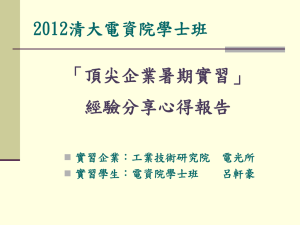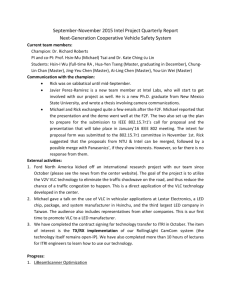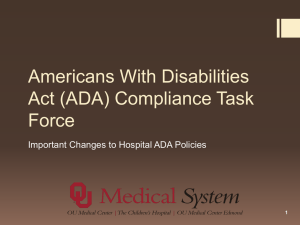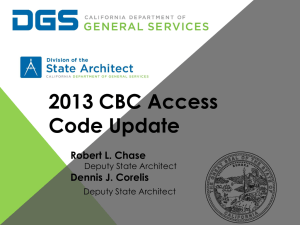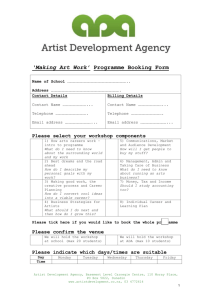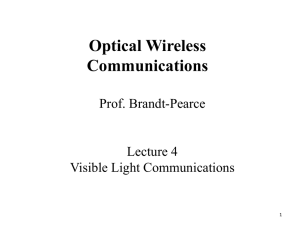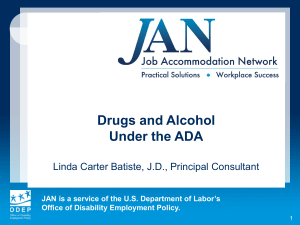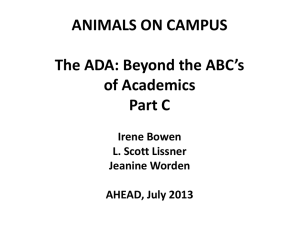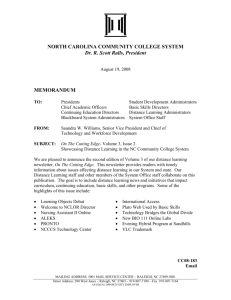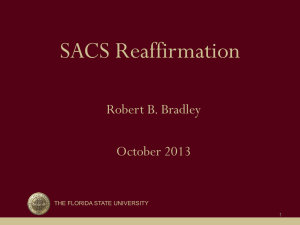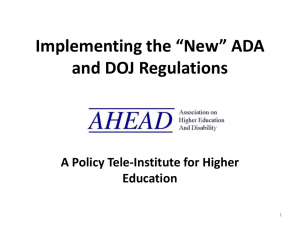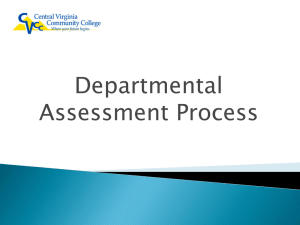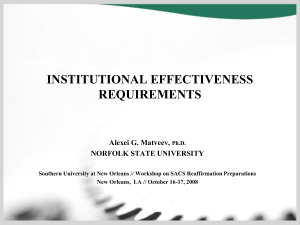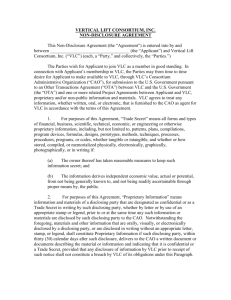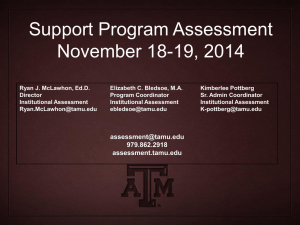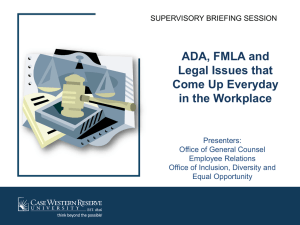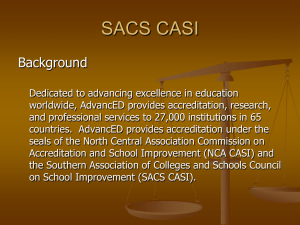DLStandardsPresentation NC3ADL
advertisement
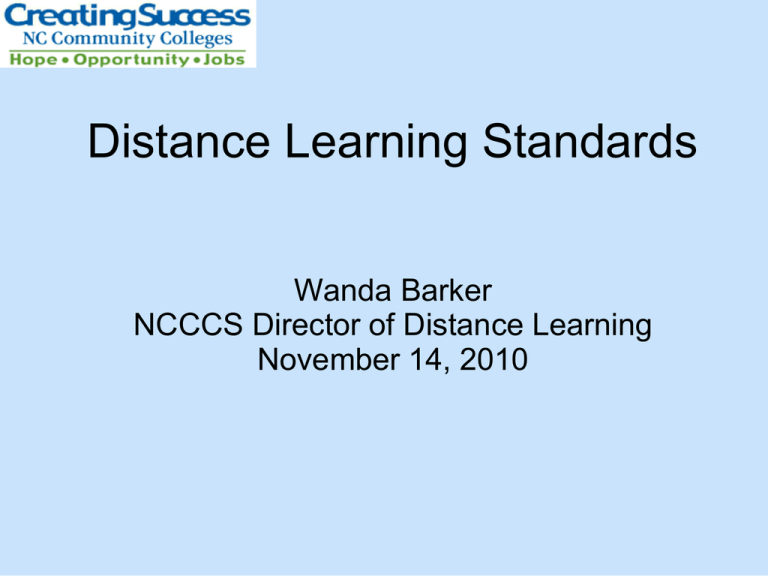
Distance Learning Standards Wanda Barker NCCCS Director of Distance Learning November 14, 2010 Session Description What are the minimum DL standards that you and your college's faculty/staff can agree to meet? In this session, we will discuss the base standards that we all agree to and are required to meet because of regulatory requirements. What about the low-hanging fruit for best practices? Join us to provide feedback for best practices that you use and what the recommendations should be for the NCCCS distance learning programs. Overview Standards – a BIG topic Who, When, Where, Why, How Regulatory Requirements SACS ADA VLC Standards Other Best Practices (Quality Matters Rubric) What are the standards on your campus? Standards So many things to consider! Online Programs and Courses Course Evaluations (Students, peers, committees) Learning Objects and Other Resources Technology Procurement Business Requirements Websites Student Services Online Faculty Certification Network Architecture Who? Stakeholders Distance Learning Administrators CE DL Administrators Instructional Officers and Academic Deans Student Services Officers Faculty representatives Librarians Student Information Systems Administrators IT Directors other Senior Leadership When? • • • • • • NOW Look at growth charts Imagine the size and scope of your program next year, in five years, in ten years! Look at System-wide numbers Some practices can be implemented without additional expenses Budgets are tight now, but when you do get money how will you use it? The Facts Growth is up and budgets are down Students want more online classes It's all about them! Their schedule, their responsibilities, their choices, their needs Saturation of technology in ALL classes Legal requirements to meet ADA standards Accreditation standards of SACS/COC Sharing of resources across our system Where do we look for standards? SACS/COC ADA Section 508 and Senate Bill 866 Southern Regional Education Board E-Learning Commission Commission on Learning Technologies (COLT) Virtual Learning Community VLC Philosophy Steps for Course Development Course Development Guide Why? The Facts E-Learning Commission is working on statewide standards Help us provide guidance to the state so that community college needs are met COLT also working on DL standards State-wide tracking system for students Requires a unique identifier of a student that can be linked from system to system and mapped to individual students throughout their education and career Longitudinal Data System • • • • • • Have you ever wondered how well your college’s transfer students do when they go to a university to complete a bachelor’s degree? Have you ever wondered what the retention rates for DL students are at your college? Have you ever wondered how much of the knowledge is retained after graduation? Have you ever wondered how well your students perform on the job after graduation? Have you ever wondered how many of your students get a job in their degree field? Have you ever wondered how students from your college perform compared to other colleges? Performance Measures • • • • • How do you want your college to perform on these measures? Do you think that enforcing some standards for elearning across the system will help? Have you seen some examples of very good and very bad courses on your campus? Have you seen examples of very good online faculty and some who are not as proficient as others? What do you think can be done to improve distance learning on your campus? How? System-wide DL Course Standards Sharing of Best Practices Online Instructor Certification Sharing and Collaboration on Training By Recommendation of COLT By Recommendation of E-learning Commission Regulatory Requirements SACS/COC ADA Section 508 Senate Bill 866 SACS/COC http://sacscoc.org/principles.asp Core Requirements Comprehensive Standards Federal Requirements Substantive Change Reporting Requirements July 2010 Updates Where to find info. about your college? http://sacscoc.org/search.asp ADA Section 508 NC Vital (http://www.ncvital.info/) Dept. of Justice Standards for Accessible Design http://www.ada.gov/stdspdf.htm http://www.section508.gov/ Senate Bill 866 General Assembly 2001 http://www.ncga.state.nc.us/Sessions/20 01/Bills/Senate/pdf/S866v3.pdf VLC Course Philosophy • • • See Philosophical Overview and All Content folders in VLC template Objectives based, collaborative assignments, ILAs, easily adapted, modular, equivalent to F2F, unified team design, include free digital resources, ADA compliant, original work, and meet the CCL description VLC Courses meet SACS, ADA, and Quality Matters standards VLC Helpful Documents Student Learning Objectives Chart Step by Step Course Development Guide Standards for VLC Courses Folder Philosophical Overview The Syllabus All Content Resources Announcements Discussion Form Modules Accessibility Start Here Quality Matters Rubric Rubric for 2008-10 developed by Maryland Online http://qminstitute.org/home/Public%20Libra ry/About%20QM/RubricStandards20082010.pdf Must answer “Yes” to all of the 3-point value questions Must have an overall score of 72 points or higher Hope Opportunity Jobs Online Course Best Practices • • Relevance Quality content • Collaborative • Interactive • Immediate Feedback • Problem based learning • Critical thinking skills • Learner-centered • • • • • Goals and Objectives (CCL) Structure Instructional Design Interactivity Universal Design and ADA compliance Hope Opportunity Jobs What are the standards at your college and what do you think should be included in system-wide and/or state-wide standards? Hope Opportunity Jobs Questions? Thank you! Hope Opportunity Jobs Contact Information Wanda Barker Director of Distance Learning NC Community College System barkerw@nccommunitycolleges.edu 11/06/10 23


